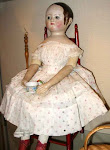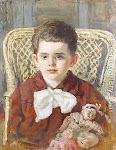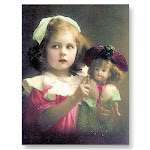 “Madmoiselle”, “You are, I know, a charming little girl. You have the quality of making everyone who draws near you, love you, and you are cherished by your good parents to whom you are a pride and joy. I know, too, that you to love to work and study, and it is to reward you for your progress that Madame, your mother, has purchased for you my humble and blonde person.” Letter of a Jumeau Baby to her Little Mother, included in the box with Jumeau Bébé doll, 1881,
“Madmoiselle”, “You are, I know, a charming little girl. You have the quality of making everyone who draws near you, love you, and you are cherished by your good parents to whom you are a pride and joy. I know, too, that you to love to work and study, and it is to reward you for your progress that Madame, your mother, has purchased for you my humble and blonde person.” Letter of a Jumeau Baby to her Little Mother, included in the box with Jumeau Bébé doll, 1881,France.
 It was a magical time in France , Bébés, or dolls made to represent children, were quite revolutionary for their time (starting about 1850), since most dolls up until that time were made to represent adults. These child dolls, with their kid or composition bodies, fine bisque heads, and beautiful expressions, were called Bébés, a significant name, since up to this time most dolls, including the popular ladies, had been known as poupees.
It was a magical time in France , Bébés, or dolls made to represent children, were quite revolutionary for their time (starting about 1850), since most dolls up until that time were made to represent adults. These child dolls, with their kid or composition bodies, fine bisque heads, and beautiful expressions, were called Bébés, a significant name, since up to this time most dolls, including the popular ladies, had been known as poupees. In the 1880’s when a lady was accompanied by her children, whether receiving at home or in public, the children had to be as fine as possible, and if the little girl was to carry a doll, it too had to be fine as well. It is not surprising then, that the Bébés were outfitted with richness and charm.
In the 1880’s when a lady was accompanied by her children, whether receiving at home or in public, the children had to be as fine as possible, and if the little girl was to carry a doll, it too had to be fine as well. It is not surprising then, that the Bébés were outfitted with richness and charm.They were usually sold exquisitely dressed, in doll-sized fashions worn by children of that era. At last there will be dolls in the little girls’ small, own image.! For the children they represented another role model; they were like sisters that never did anything naughty, never played in the dirt, always listened and hardly ever spoke a word.
 As thus, what was sweeping France in the 1870’s and 1880’s was the new companion of the child, their younger selves, in the form of a superb doll with a curious and compelling aura, brilliant blue eyes and the look of childish wistfulness.
As thus, what was sweeping France in the 1870’s and 1880’s was the new companion of the child, their younger selves, in the form of a superb doll with a curious and compelling aura, brilliant blue eyes and the look of childish wistfulness. 
painted lashes, and beautifully painted brows in layered multi-strokes. Closed mouth with a slightly molded tongue between the shaded, and outlined lips. Long blonde human hair wig, that falls to the waist in tight curls.
Her couture includes what may be her original dress. Bonnet is also antique black or very dark blue velvet with a wide brim, feather plumes and long velvet ties. It is held in place with an antique hat pin. She is wearing her original Bee marked Jumeau shoes and carries an antique parasol of turquoise and pink silk.
 Depose -Tete Jumeau 13, holding a Marotte Doll ca. 1880
Depose -Tete Jumeau 13, holding a Marotte Doll ca. 1880Body made of wood, all original doll. Dress bears the label "Maison Parisienne Bertone C. Milano

Jumeau was the French manufacturing firm responsible with the evolution of dolls between 1841 and 1899. They were pristine and immaculately dressed, the essence of the great French doll. Symbols of their age and invaluable records of the fashions and aesthetic ideals of the period. By 1873 the firm was a highly efficient organization. Pierre-Francoise Jumeau was joined by his son, Emile, who took the leap that opened the way to new industrial methods. These were the years the Bebe Jumeau became fully established and a team of skilled workers were being made responsible for the various components of the doll. One person would work on the moulds for the different parts of the body. The most skilful will decorate the heads. A special section was employed in making the beautiful glass eyes that were the pride of the firm and set the standard for other companies to follow. The dynasty peaked in 1890 when bebes were made with parted lips to reveal lovely porcelain teeth. In spite of this success, this period marked the beginning of a gradual decline. Mass production brought about a reduction of the high standards of the dolls from earlier years and the company was beset by fierce competition from German firms that managed to maintain low prices and high productivity.
 Who knows how many children tired out after playing, quite nervously, with their precious but most fragile Bebe, would not have preferred to lock it away in its box, and curl up instead with a soft and undemanding Teddy Bear.
Who knows how many children tired out after playing, quite nervously, with their precious but most fragile Bebe, would not have preferred to lock it away in its box, and curl up instead with a soft and undemanding Teddy Bear. Le Journal des Enfant ca. 1884...Depicting a group of the sophisticated Parisian
Le Journal des Enfant ca. 1884...Depicting a group of the sophisticated Parisianchildren who are reflected in the bebes.
**************************************
 The first impression upon looking at a doll made by Leon-Casimir Bru is that is undeniable beautiful. Its remote, almost rapt expression, the intense look in eyes that seem to be gazing into the distance. A slight smile on half closed lips that made the doll fascinating and lifelike.
The first impression upon looking at a doll made by Leon-Casimir Bru is that is undeniable beautiful. Its remote, almost rapt expression, the intense look in eyes that seem to be gazing into the distance. A slight smile on half closed lips that made the doll fascinating and lifelike. BRU 8 Perfect bisque head and shoulderplate, featuring that “vulnerable, concerned look” we all love. In addition, there is a very prominent tongue, indescribable pale blue paperweight eyes, mauve shadow, a fabulous antique deep blonde mohair wig, and pierced ears. Patented Chevrot body with lower carved wooden legs, and lovely bisque arms. Mademoiselle Bru wears a lovely ensemble in gorgeous pale pink brocade with pale pink chiffon and lace accents. In addition, she wears a matching dramatic chapeau, antique under things, and black leather bebe shoes.
BRU 8 Perfect bisque head and shoulderplate, featuring that “vulnerable, concerned look” we all love. In addition, there is a very prominent tongue, indescribable pale blue paperweight eyes, mauve shadow, a fabulous antique deep blonde mohair wig, and pierced ears. Patented Chevrot body with lower carved wooden legs, and lovely bisque arms. Mademoiselle Bru wears a lovely ensemble in gorgeous pale pink brocade with pale pink chiffon and lace accents. In addition, she wears a matching dramatic chapeau, antique under things, and black leather bebe shoes. BRU Jne 9 ca. 1885
BRU Jne 9 ca. 1885


 "Jules Steiner"
"Jules Steiner"Gorgeous Steiner all original with antique dress and parasol

An extraordinary Series C Steiner with lever eyes of deep blue enamel, mauve eye shadow, closed mouth, full moon face with delicate coloring over smooth, ivory bisque and original, long, luscious blond mohair wig. She has a gray cardboard pate with remnants of a French label, however the originality is not certain. Her early, chunky Steiner body with straight wrists and robust, so called "banana" hands, wears her white pique antique frock so well. Topped off with an antique, flower-adorned black bonnet and black leather shoes, she is brimming with style and substance..
 " Bébé Steiner Gigoteur," vers 1870...Le Musée de la Poupée, Paris
" Bébé Steiner Gigoteur," vers 1870...Le Musée de la Poupée, Paris*****************************

 A French Fashion Plate ca. 1880. The elegant child is being offered a bebe from a stall in a Parisian arcade. The doll is even more splendidly dressed than the girl herself.
A French Fashion Plate ca. 1880. The elegant child is being offered a bebe from a stall in a Parisian arcade. The doll is even more splendidly dressed than the girl herself.************************************

 "Portrait of Catherine du Bouchage"... Thank you Phillip.
"Portrait of Catherine du Bouchage"... Thank you Phillip.
They were showered with affection by the children that were so eager to give it. But once the child had enjoyed a few minutes of excitement and pleasure, the precious doll would inevitably be packed away by some wise grandmother for safe keeping, and only brought out on special occasions. The fact that child was forbidden to play with it freely, caused the doll to be more desirable, but at the same time was gradually forgotten, tucked away in some dark attic. Consequently, these dolls survived their original owners, to be re-discovered later by some other adoring child. To the delight of today’s collectors, many of these dolls, although showing the scars of time, are given another chance to shine in their glory, thus proving they are far too precious to be discarded forever.













































.jpg)






































































They are so beautiful, but as you say look rather too precious to actually play with.
ReplyDeleteLucky for today's collector that was the case. These dolls were only to be admired and then put away. The closest I've come to own a Bebe is an SFBJ, she is indeed beautiful, but lacks the softness of the coloring. I still dream of owning a Bru. There are some very talented artists out there, that do wonderful reproductions. But I can't quite make myself purchase a repro....I guess I'll never own one then.
ReplyDeleteLAS MUÑECAS... han sido mis idolos de niñez,todas me gustaban y mi padre en cada viaje me traia una nueva, era una persona más en mi vida, sentian me querian y las adoraba,.
ReplyDeleteHe pasado un rato maravilloso viendo tan estupendas muñecas, y postales de niñas dando ese amor que solo un ser inocente sabe dar y comprendiendo a sus muñecas como solo cuando se es pequeña se puede comprender.
GRACIAS POR TU BLOG
UN abrazo
Maite
Gracias Maite...Mucho gusto me da que te guste mi blog. Al igual que tu, yo adoraba a mis muñecas de niña, siendo hija unica, pasaba muchas horas jugando con ellas a solas y eran com mis hermanitas. Hoy me deleito en coleccionar algunas antiguas que tengo a mi alcanze, Y, a veces todavia juego con ellas...Como miniaturista que eres, veo que tambien has mantenido tu pasion desde niña...Que bueno!
ReplyDeleteMuchos cariños Y nunca dejes de jugar a las muñecas
Marta
Hi Marta, nice to see you again today.. your blog updates are FABulous..and thank you for the acknowledgement of the Triste Long Face Jumeau, wish I could afford to keep her and the Steiner..oh my! Dolly hugs, Bonnie
ReplyDeleteHola Marta.
ReplyDeleteMe dejaron impresionado esas Bru dolls, cuando ví tu post el otro día. Esas caras son especiales y además, su ropa es increíble. Todos esos plisados, encajes, puntillas y lazos... son réplicas exactas de los vestidos auténticos de las niñas de la época. me han parecido fascinantes.
Siento no habertelo dicho antes. veo tus posts y dejo los comentarios para otro momento (Allways busy...) y pasan los días.
Es un placer ver todo lo que nos cuentas en tus posts.
Un beso.